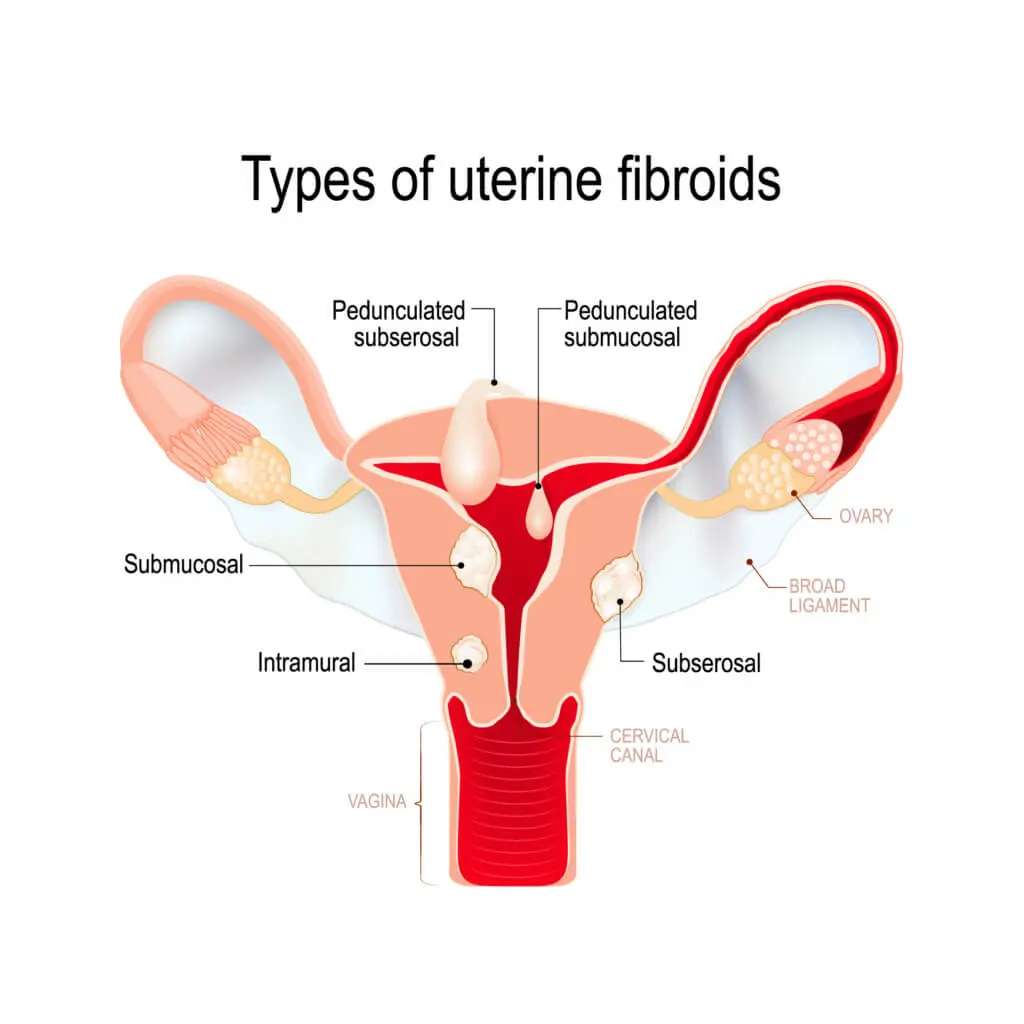
What are uterine fibroids and polyps?
Uterine fibroids and polyps are abnormal growths in your uterus that can cause discomfort, bleeding and infertility. These growths are almost always benign (non-cancerous), but polyps do have the potential to become cancerous.
Fibroids and polyps are common gynecological disorders with 80% of women developing one or more growths in their lifetime. With medication or surgery most symptoms can be remedied, and you can expect to go on to have a healthy lifestyle and pregnancy.
How are fibroids different from polyps?
While both fibroids and polyps are abnormal uterine growths, they vary in form and location. Fibroids are muscular growths within the walls of the uterus, while polyps form on the lining of the uterus.
There are three main types of fibroids based on where they are found:
- Subserosal are in the outer wall of the uterus (55%)
- Intramural are found in the muscular layers of the uterine wall (40%)
- Submucosal protrude into the uterine cavity (5%)
Polyps usually stay inside your uterus, but they can sometimes be found in your vagina or blocking your fallopian tubes.
Fibroids can grow much larger than polyps (up to melon size), and they typically grow larger during pregnancy before returning to their former size after delivery. Polyps are smaller, usually growing only up to the size of a golf ball, and they don’t grow during pregnancy.
Fibroids are more common than polyps in the child-bearing age group because your uterus sheds its lining during each menstrual cycle, making it difficult for polyps to form. But while post-menopausal women are more likely to develop polyps since they stop menstruating, it is not unheard of for pre-menopausal women to also have polyps.

Fibroid & Polyp Symptoms
Most women with fibroids and polyps will experience no symptoms at all. However, the size, quantity and/or location of growths may cause some of the following symptoms. Once symptoms begin to interfere with your daily life or fertility journey, you should consider treatment.
Fibroid Symptoms
- Heavy or painful periods
- Feeling of fullness
- Enlargement of the abdomen
- Frequent urination
- Infertility
Uterine Polyps Symptoms
- Irregular menstrual cycles
- Bleeding between menstrual cycles
- Heavy periods
- Post-menopausal bleeding
- Pain during intercourse
- Infertility

Fibroids, Polyps & Fertility
In the majority of cases, fibroids and polyps do not affect your fertility. It is important to rule out any other fertility factors between you and your partner before determining that fibroids or polyps are inhibiting your ability to conceive. However, approximately 5%-10% of infertile women have abnormal uterine growths, so it is not to be overlooked.
The most common fibroids that affect fertility are submucosal, the ones that protrude into the uterus. Occasionally, other types of fibroids can affect fertility, depending on their size and location. The American Society for Reproductive Medicine notes there are several ways uterine fibroids can reduce fertility:
- Changes in the shape of the cervix can affect the number of sperm that can enter the uterus.
- Changes in the shape of the uterus can interfere with the movement of the sperm or embryo.
- Fallopian tubes can be blocked by fibroids.
- They can impact the size of the lining of the uterine cavity.
- Blood flow to the uterine cavity can be affected. This can decrease the ability of an embryo to stick (implant) to the uterine wall or to develop.
Polyps can also affect fertility, though the reasons are less well known. It is theorized that polyps interfere with the uterine lining in a way that makes it difficult for an embryo to implant.
Treatment for Fibroids & Polyps
Most fibroids and polyps need no treatment, but if it is determined that they are affecting your life and/or fertility, treatment may be recommended. In some cases, medication can relieve your symptoms, though it will not help your infertility. If pregnancy is your goal, surgery might be necessary to remove your uterine growths.
The course of treatment we recommend at Inovi is hysteroscopy or hysteroscopic myomectomy. These procedures can remove polyps and fibroids while leaving your uterus in tact and avoiding the risk of internal scarring that could affect future fertility.
The fibroid and uterine polyp removal recovery time is typically two weeks, but you can usually return to work the day after your procedure. Cramping, abdominal pain and vaginal bleeding may occur, and you should wait a full two weeks before engaging in sexual intercourse.
Think you might have fibroids or polyps?
Give us a call at 713-401-9000 to schedule a consultation. Dr. Stephan Krotz and his team will give you a thorough evaluation to determine the right treatment for you.
